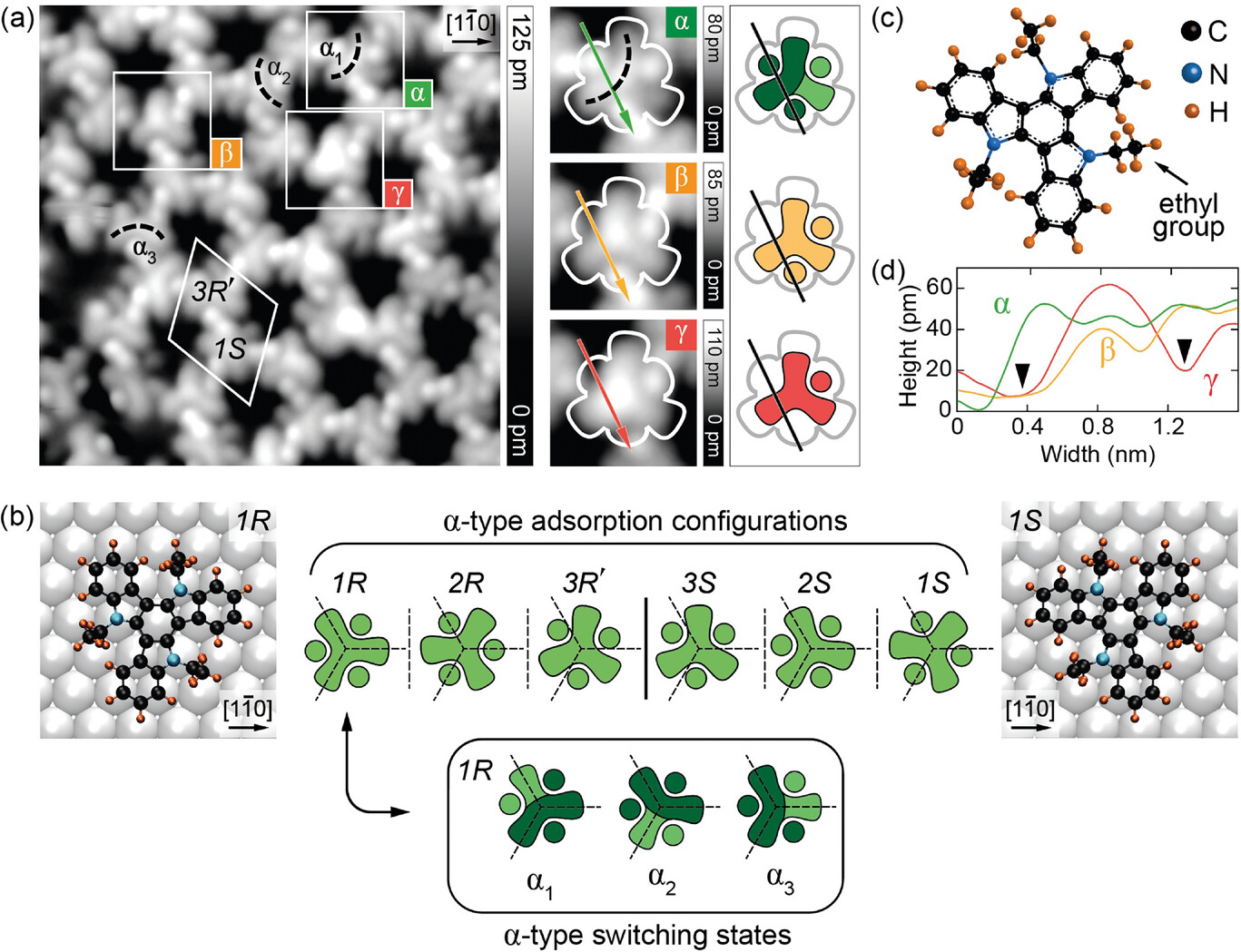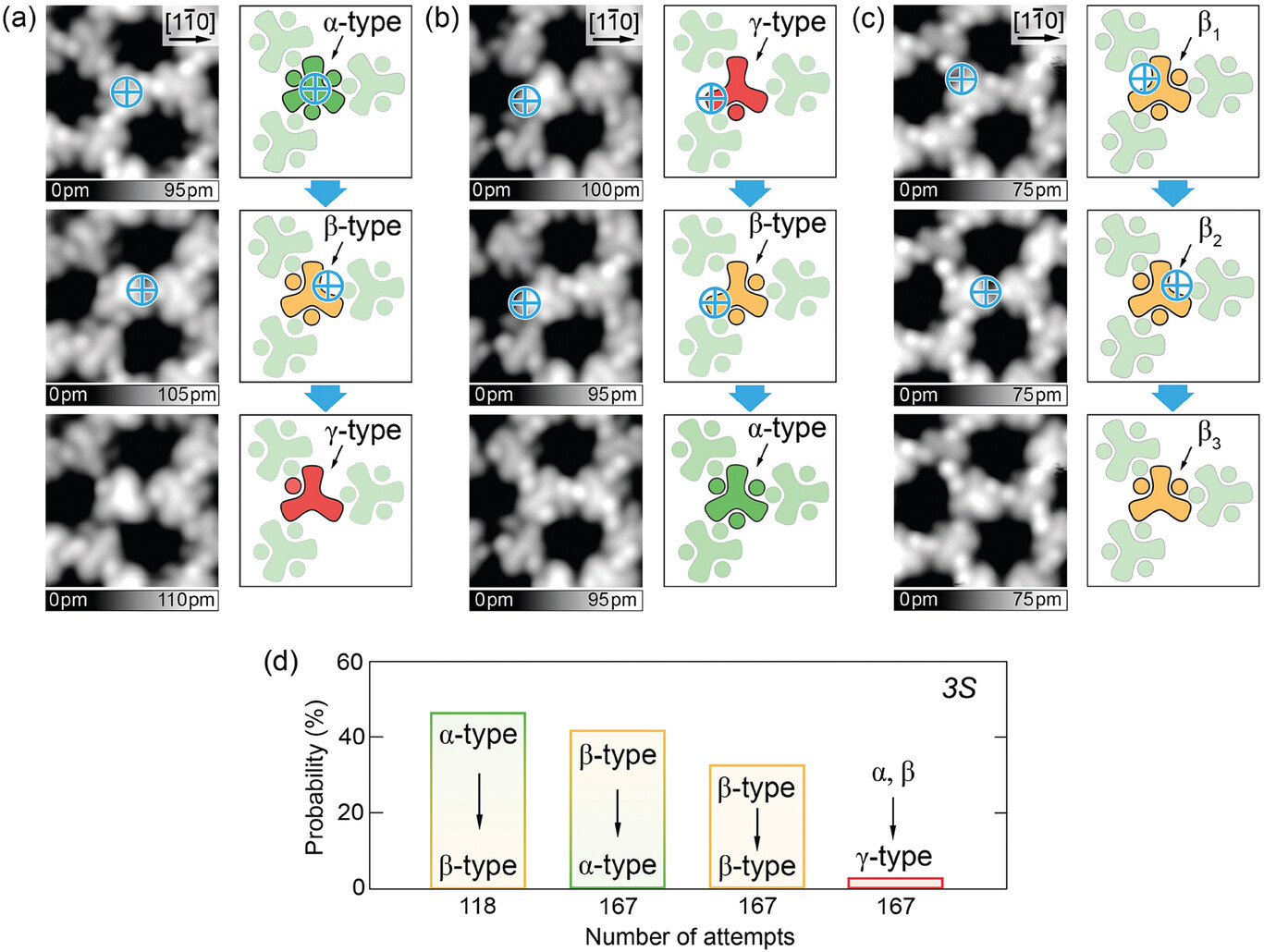| Jul 30, 2024 | |
Molecular switches demonstrate complex behavior advancing potential for ultra-dense memory |
|
| (Nanowerk Spotlight) The miniaturization of electronic components has been a driving force in technological advancement, pushing the boundaries of computing power and efficiency. As silicon-based devices approach their physical limits, researchers have increasingly focused on the molecular scale, where individual molecules could serve as the fundamental units of logic and memory. This approach offers the potential for unprecedented information density and novel functionalities that could transform the landscape of computing. However, harnessing molecules as reliable electronic components has proven to be a complex challenge, requiring exquisite control over molecular behavior and the ability to create stable, sophisticated systems. | |
| Initial forays into molecular electronics centered on simple bistable switches. While these early efforts were pivotal, they underscored the need for more advanced molecular architectures to achieve the complexity necessary for practical applications. Scientists explored various switching mechanisms, including conformational changes, charge states, and chemical reactions, gradually building a deeper understanding of how to manipulate matter at the atomic scale. | |
| Recent years have witnessed significant advancements in the tools and techniques available to researchers in this field. Scanning probe microscopy, particularly scanning tunneling microscopy (STM), has evolved to allow unprecedented control and characterization of individual molecules on surfaces. | |
| Concurrently, synthetic chemistry has expanded the repertoire of molecular building blocks, providing scientists with a richer palette of structures and properties to work with. These developments have paved the way for more ambitious efforts to create programmable molecular systems with the potential to rival or surpass conventional electronics. | |
| A team of researchers from the University of Konstanz and other German institutions has now demonstrated a sophisticated multi-state molecular memory system that represents a significant step forward in this field. Their work, published in Advanced Materials ("Fully Reprogrammable 2D Array of Multistate Molecular Switching Units"), showcases an ordered two-dimensional array of molecular switches with an extraordinary degree of control over multiple distinct states. | |
 |
|
| Honeycomb lattice of TAT on Ag(111). a) Topographic STM image of a TAT island (9.5 × 9.5 nm2; I = 100 pA; U = 20 mV). The unit cell (white rhombus) consists of two TAT enantiomers adsorbed in different geometries – 1S and 3R′. Three molecular types (𝛼, 𝛽, and 𝛾) within the 3R′ configuration are marked by boxes. Magnifications (2 × 2 nm2) of the boxed TAT molecules are shown on the right-hand side. Pictograms for each TAT type are introduced, which depicts the STM intensity distribution. Filled circles represent the bright circular protrusions in the STM, corresponding to the upstanding ethyl groups. Black lines denote the height profiles. b) Upper row: top views of the adsorption configurations of two surface enantiomers (1S - calculated geometry and 1R - schematic representation) observed for free-standing 𝛼-type TAT molecules. Additionally, schematic representations of six different adsorption configurations for the 𝛼-type TAT molecule observed in the experiments are shown. Adsorption configurations 3R′ and 3S are not exactly mirror symmetric as discussed in the text. Bottom row: schematic representation of the three degenerate bonding states exemplarily presented for the 1R 𝛼-type TAT (𝛼1, 𝛼2, and 𝛼3), which can be distinguished by the different orientation of the characteristic boomerang-shaped feature indicated by the dark-shaded area within the molecular backbone (marked by dashed bows in “a”). Height differences of the three maxima of single 𝛼-type TAT molecule are highlighted by light and dark green. c) Molecular structure of the TAT molecule. The ethyl groups are pointing out of the plane. d) Height profiles along the green (𝛼-type), yellow (𝛽-type), and red (𝛾-type) arrows shown in “a”. Black triangles denote the positions of strongly bound ethyl groups in 𝛽- and 𝛾-type TAT molecules. (Image: reproduced from DOI:10.1002/adma.202401662, CC-BY) | |
| The researchers utilized a molecule called triazatruxene (TAT) as their fundamental unit. TAT is a star-shaped organic molecule with three "arms" extending from a central core. When deposited on a silver surface, these molecules self-assemble into a honeycomb lattice structure, creating a regular array of potential switching units. | |
| Using an STM, the team manipulated individual TAT molecules within this array with remarkable precision. They discovered that each molecule could adopt three distinct "types," labeled α, β, and γ. These types differ in how the molecule's flexible side groups (ethyl groups) interact with the silver surface. | |
| The α-type configuration features three ethyl groups pointing outward, allowing for a certain type of switching behavior. The β-type has one ethyl group interacting more closely with the surface, while the γ-type has two such interactions. The researchers found they could reversibly switch between these types by applying specific voltages with the STM tip. | |
| Importantly, at higher bias voltages (2.0-2.6 V), the researchers could induce reversible transitions between the types without notable changes in their lateral position, which is a significant finding for potential device applications. | |
| The complexity of the system extends beyond these three basic types. Within each type, the TAT molecules can adopt multiple configurations due to their orientation and interaction with the silver surface. For the α-type, there are three equivalent orientations. The β-type has six distinct states when considering both its orientation and which specific ethyl group interacts with the surface. In total, the researchers identified 12 unique, controllable states for each TAT molecule. | |
| This hierarchical switching behavior creates a rich landscape of possibilities for information storage and processing. Hierarchical switching allows for the precise control of molecular states, essential for developing high-density memory systems. The team demonstrated that they could "program" specific patterns of molecular states within the array by selectively applying different voltages to individual molecules. | |
| One of the most intriguing aspects of the system is the influence of neighboring molecules on each other's behavior. The researchers found that adjacent α-type molecules influence each other's low-voltage switching, leading to correlated behavior. By carefully arranging active (α-type) and passive (β- or γ-type) molecules, they created coupled units of two or four interacting switches. | |
| In the most complex configuration studied, a unit of four interacting α-type molecules exhibited 19 distinct observable states, with the theoretical potential for up to 81 states. Crucially, the state of the entire unit could be read out by measuring just one of the molecules. This opens up the possibility of creating dense memory arrays where multiple bits of information are encoded in the collective state of a small cluster of molecules. | |
| The researchers also observed interesting dynamics in how these molecular clusters switch between states. The switching rates depend on the distance from where the STM injects electrons, potentially allowing separate "write" and "read" operations within a single molecular unit. | |
 |
|
| Tip-induced conformational changes of TAT. a) Topographic STM images (left) and corresponding pictograms (right) illustrating tip-induced switching sequences between three different conformations of the central 3S-TAT molecule: 𝛼 → 𝛽 → 𝛾. b) Inverse switching sequence for the same molecule: 𝛾 →𝛽 →𝛼. c) Tip-induced changes between three degenerate ground states of the 𝛽-type TAT molecule. All images: 4 × 4 nm2; U = 20 mV; I = 100 pA. The lateral tip positions for each bias ramp are marked by blue crosses in the STM images and pictograms. Number of attempts for a successful switching event: (a) 1, 1; (b) 1, 1; (c) 1, 1. d) Probability histogram for tip-induced switching between the types. Ramping parameters for all experiments: voltage range: 2.0 - 2.6 V; ramp speed: 0.2 V/s; I = 500 pA. (Image: reproduced from DOI:10.1002/adma.202401662, CC-BY) | |
| While this work remains in the realm of fundamental research, it represents a significant step towards realizing practical molecular-scale electronic devices. The high degree of control over multiple states, the ability to program specific configurations, and the emergence of collective behavior in molecular clusters are all promising characteristics for future memory or logic applications. | |
| Several key challenges remain before such systems could be practically implemented. The experiments were conducted at extremely low temperatures (around 5 Kelvin) to stabilize the molecular states. Finding ways to maintain similar functionality at higher temperatures will be crucial for real-world applications. | |
| Additionally, while the STM allows exquisite control over individual molecules, it is not a scalable method for addressing large arrays. Developing alternative means of interfacing with molecular switches is necessary. Future research may explore the use of nanoscale electrodes or other advanced techniques to create more practical, large-scale implementations of these molecular memory systems. | |
| This research opens up new avenues for exploration in molecular electronics. The ability to create and manipulate complex, interacting networks of molecular switches could potentially lead to novel computing architectures that go beyond simple binary logic. As our understanding of these systems grows, researchers may discover new ways of processing and storing information at the molecular scale. | |
| The work also highlights the power of interdisciplinary collaboration in tackling complex scientific challenges. This project brought together expertise in surface science, synthetic chemistry, and theoretical modeling to achieve its results. As the field of molecular electronics continues to advance, such collaborative approaches will likely become increasingly important. | |
 By
Michael
Berger
– Michael is author of three books by the Royal Society of Chemistry:
Nano-Society: Pushing the Boundaries of Technology,
Nanotechnology: The Future is Tiny, and
Nanoengineering: The Skills and Tools Making Technology Invisible
Copyright ©
Nanowerk LLC
By
Michael
Berger
– Michael is author of three books by the Royal Society of Chemistry:
Nano-Society: Pushing the Boundaries of Technology,
Nanotechnology: The Future is Tiny, and
Nanoengineering: The Skills and Tools Making Technology Invisible
Copyright ©
Nanowerk LLC
|
|
|
Become a Spotlight guest author! Join our large and growing group of guest contributors. Have you just published a scientific paper or have other exciting developments to share with the nanotechnology community? Here is how to publish on nanowerk.com. |
|
